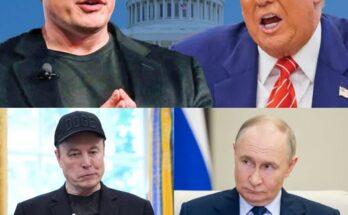In a significant and controversial decision, President Donald Trump has announced a “pause” on U.S. military aid to Ukraine, a move that has sparked intense debate on the international stage. The decision, reportedly aimed at pressuring Ukrainian President Volodymyr Zelenskyy into engaging in peace talks with Russia, follows a tense meeting in which Trump and Vice President JD Vance confronted Zelenskyy over what they perceived as a lack of gratitude for U.S. support. While some view the decision as a strategic effort to push for diplomacy, others have criticized it as reckless, arguing that it could weaken Ukraine’s defenses against Russian aggression.

The Context Behind the Decision
Since the onset of Russia’s full-scale invasion of Ukraine in 2022, the United States has been a major supplier of military aid, providing billions of dollars in weaponry, intelligence, and financial support. The assistance has played a crucial role in bolstering Ukraine’s military capabilities, enabling it to resist Russian advances and launch counteroffensives. However, as the war drags on with no clear resolution in sight, pressure has mounted within the U.S. government to reevaluate its long-term commitment to Ukraine.
Trump, who has long expressed skepticism about extensive foreign aid programs, has signaled a shift in U.S. policy by pausing military assistance. During a high-stakes meeting with Zelenskyy, Trump reportedly expressed frustration over what he perceived as a lack of acknowledgment from Ukraine regarding the sacrifices made by the United States. Vice President JD Vance, known for his more isolationist stance, reinforced this sentiment, pressing Zelenskyy to make greater efforts toward negotiating a peace deal with Russia.
The Impact on U.S.-Ukraine Relations
The pause in military aid has introduced new tensions in the relationship between Washington and Kyiv. While Zelenskyy has expressed gratitude for past U.S. support, he has also emphasized that Ukraine’s ability to defend itself depends on a steady supply of Western weapons. The decision to halt aid, even temporarily, raises concerns about whether Ukraine will be able to sustain its current level of resistance against Russian forces.
Critics argue that the move could embolden Russian President Vladimir Putin, who may interpret the pause as a sign of waning U.S. commitment. Some analysts believe that if Ukraine faces a shortage of military resources, Russia could seize the opportunity to intensify its offensives, potentially altering the balance of power on the battlefield.
Domestic Political Ramifications
Trump’s decision has also ignited fierce debate within the United States. Supporters of the move, including members of the “America First” wing of the Republican Party, argue that the U.S. has already contributed significantly to Ukraine’s defense and that it is time for European allies to shoulder more of the burden. They contend that prolonged military involvement in Ukraine could drain American resources and divert attention from domestic priorities.
On the other hand, critics, including many Democrats and foreign policy experts, warn that abandoning Ukraine at a critical juncture could have dire consequences for global security. They argue that the U.S. has a moral and strategic obligation to support Ukraine against Russian aggression, as failure to do so could undermine American credibility and embolden authoritarian regimes worldwide.
International Reactions
The international response to Trump’s decision has been mixed. NATO allies, particularly countries in Eastern Europe, have expressed concern that a reduction in U.S. support could weaken the collective effort to deter Russian expansionism. European Union leaders have urged the U.S. to reconsider, emphasizing that sustained Western unity is essential in countering Russian aggression.
Conversely, Moscow has welcomed the development, with Russian officials suggesting that the move signals cracks in Western resolve. The Kremlin has repeatedly claimed that Ukraine’s reliance on Western aid is unsustainable and that negotiations are the only viable path to ending the conflict. Whether Trump’s decision will push Ukraine toward diplomatic engagement or merely weaken its negotiating position remains a subject of intense speculation.
Potential Consequences for Ukraine’s War Effort
Pausing military aid could have immediate and long-term consequences for Ukraine’s war effort. Ukrainian forces have relied heavily on U.S.-supplied weaponry, including advanced missile systems, tanks, and air defense systems. A disruption in this supply chain could hamper Ukraine’s ability to launch counterattacks or defend critical territories.
Moreover, Ukraine’s military strategy has been closely tied to the expectation of continued Western support. If aid remains frozen for an extended period, Ukrainian commanders may be forced to adjust their tactics, potentially prioritizing defensive operations over offensive maneuvers. This shift could give Russia an advantage, allowing its forces to regroup and strengthen their positions.
Trump’s Larger Foreign Policy Vision
The decision to pause military aid to Ukraine aligns with Trump’s broader foreign policy approach, which prioritizes national interests over traditional alliances. Throughout his political career, Trump has been critical of extensive U.S. involvement in foreign conflicts and has advocated for burden-sharing among allies. His administration’s stance on Ukraine reflects this philosophy, signaling a potential recalibration of U.S. engagement in global security affairs.
Trump’s approach, however, also raises questions about the future of U.S. leadership on the world stage. While his supporters praise his efforts to reassess America’s role in international conflicts, detractors argue that disengaging from Ukraine could weaken the U.S.’s influence and credibility. If other nations perceive the U.S. as an unreliable ally, it could have ripple effects on global partnerships and security arrangements.
The Path Forward
As the situation unfolds, the next steps will be crucial in determining the outcome of Trump’s policy shift. The U.S. Congress, where support for Ukraine remains relatively strong, could push back against the decision, potentially seeking ways to reinstate funding. Additionally, diplomatic efforts may intensify, with U.S. officials working behind the scenes to broker a settlement that balances military assistance with pressure for negotiations.
For Ukraine, the challenge will be to navigate this period of uncertainty while maintaining its defensive capabilities. Zelenskyy may explore alternative sources of military aid from European nations or seek reassurances from NATO about continued support. At the same time, Kyiv will need to assess the feasibility of engaging in peace talks, weighing the risks of negotiations against the dangers of a prolonged conflict with diminished resources.
Conclusion
President Trump’s decision to pause military aid to Ukraine represents a pivotal moment in U.S. foreign policy. While the move is intended to pressure Ukraine into peace negotiations, it carries significant risks that could alter the dynamics of the war. The response from domestic and international stakeholders will shape the trajectory of U.S.-Ukraine relations and influence the broader geopolitical landscape. Whether this decision ultimately leads to a diplomatic breakthrough or exacerbates the challenges facing Ukraine remains to be seen.


